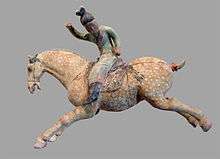Protectorate General to Pacify the East
| Protectorate General to Pacify the East | |||||||||
| Chinese name | |||||||||
|---|---|---|---|---|---|---|---|---|---|
| Traditional Chinese | 安東都護府 | ||||||||
| |||||||||
| Korean name | |||||||||
| Hangul | 안동 도호부 | ||||||||
| Hanja | 安東都護府 | ||||||||
| |||||||||
| Duhu Tang dynasty |
|---|
The Protectorate-General to Pacify the East was a short-lived military government established at Pyongyang by the Tang Dynasty of China in 668 that assumed temporary control over portions of the Korean Peninsula after the end of the Three Kingdoms Period. It played an important role in the turbulent events following the end of the Three Kingdoms period until its expulsion from the Korean Peninsula by Silla in 676, and subsequently its destruction in Manchuria by Balhae forces in 756.
The protectorate was established shortly after the kingdoms of Goguryeo and Baekje were overthrown by allied Tang and Silla forces. It was governed by the Tang general Xue Rengui. The Tang established it to govern not only the commanderies established on former Goguryeo and Baekje territories, but also in an attempt to assert control over Silla as well.
Silla retaliated against the Protectorate's attempt at establishing suzerainty on the Korean peninsula by aiding Geom Mojam's rebellion in the north, and attacking Protectorate forces in former Baekje territory. In 671 Silla seized Sabi Castle from the Tang armies. They overthrew the puppet government of Buyeo Yung which had been established there. Angered, Tang declared a younger brother of King Munmu to be Silla's rightful ruler, but was unable to follow this symbolic blow with a military one.
At the conclusion of the Silla–Tang Wars, Silla forces expelled the Protectorate armies from the entirety of the Korean Peninsula in 676. The Protectorate's capital was officially transferred to the former Goguryeon city of Shinseong, where it continued to oversee the affairs of Goguryeo refugees and portions of the former Goguryeo territory.
The deposed king of Goguryeo, King Bojang was redesignated "King of Joseon" (Hangul : 요동주도독 조선왕 Hanja: 遼東州都督朝鮮王) and made governor of the Protectorate. His persistent activities in aiding rebellions led to his eventual banishment, but Bojang's descendants continued to govern the Protectorate for several generations. The Protectorate of this period is sometimes referred to as "Little Goguryeo" or "Lesser Goguryeo".
Local unrest and the rising power of Balhae forced the Protectorate to change capitals several times. The Protectorate was finally extinguished in 756 as Balhae assumed power in Manchuria.
Administration
Administratively, it was intended to oversee nine commanderies, 42 prefectures (later reorganized into 14) and 100 counties.
Nine commanderies
- Sinseongju (Hangul: 신성주 Hanja/Hanzi: 新城州)
- Yoseongju (Hangul: 요성주Hanja/Hanzi: 遼城州/辽城州)
- Gamulju (Hangul: 가물주 Hanja/Hanzi: 哥勿州)
- Wirakju (Hangul: 위락주Hanja/Hanzi: 衛樂州/卫乐州)
- Saraju (Hangul: 사리주 Hanja/Hanzi: 舍利州)
- Geosoju (Hangul: 거소주 Hanja/Hanzi: 去素州/居素州)
- Wueolhuiji (Hangul: 월희주 Hanja/Hanzi: 越喜州)
- Geodanju (Hangul: 거단주 Hanja/Hanzi: 去旦州)
- Geonanju (Hangul: 건안주 Hanja/Hanzi: 建安州)
14 prefectures(州)
- Namso (Hangul: 남소주 Hanja/Hanzi: 南蘇州)
- Gaemo (Hangul: 개모주 Hanja/Hanzi: 蓋牟州)
- Daena (Hangul: 대나주 Hanja/Hanzi: 大那州)
- Changam (Hangul: 창암주 Hanja/Hanzi: 倉巖州)
- Mami (Hangul: 마미주 Hanja/Hanzi: 磨米州)
- Jeokri (Hangul: 적리주 Hanja/Hanzi: 積利州)
- Yeosan (Hangul: 여산주 Hanja/Hanzi: 黎山州)
- Yeonjin (Hangul: 연진주 Hanja/Hanzi: 延津州)
- Mokjeo (Hangul: 목저주 Hanja/Hanzi: 木底州)
- Ansi (Hangul: 안시주 Hanja/Hanzi: 安市州)
- Chebok (Hangul: 제북주 Hanja/Hanzi: 諸北州)
- Shikri (Hangul: 식리주 Hanja/Hanzi: 識利州)
- Buryeol (Hangul: 불열주 Hanja/Hanzi: 拂涅州)
- Baehan (Hangul: 배한주 Hanja/Hanzi: 拜漢州)
Governors
- Xue Rengui (614–683) - 안동도호부사/安東都護府使
- Go Bojang (677–681) - (Hangul : 요동주도독 조선왕 Hanja:遼東州都督朝鮮王) and (Hangul : 조선군왕 Hanja:朝鮮郡王)
- Go Gusu (Hangul : 고구수 Hanja: 高仇須) (664?–738?) - 안동도독/安東都督
- Go Bowon (Hangul : 고보원 Hanja: 高寶元) (686–?), Grandson of Bojang (Hangul : 조선군왕 Hanja:朝鮮郡王) later (Hangul : 충성국왕 Hanja:忠誠國王)
- Go Deokmu (Hangul : 고덕무 Hanja: 高德武), Son of Bojang - 안동도독/安東都督
- Go Jin (Hangul : 고진 Hanja : (高辰) (700–773) Grandson of Bojang
- Xue Na : 薛訥 - 安東道經略 안동도경락
References
- Lee, K.-b. (1984). A new history of Korea. Tr. by E.W. Wagner & E.J. Schulz, based on the Korean rev. ed. of 1979. Seoul: Ilchogak. ISBN 89-337-0204-0
See also
- Chinese military history
- Four Commanderies of Han
- History of China
- History of Korea
- List of Korea-related topics
- Three Kingdoms of Korea
